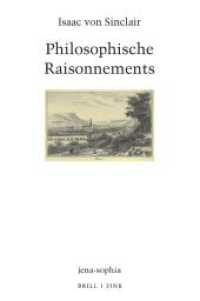- ホーム
- > 洋書
- > ドイツ書
- > Humanities, Arts & Music
- > Linguistics
- > romanic linguistics
Full Description
Several poetic and prose compositions in early Italian literature contain references to the bubonic plague and other illnesses that were used in the language both literally and metaphorically. The first detailed description of a plague epidemic, however, was written by Giovanni Boccaccio in the introduction to The Decameron. It is a precise and dramatic view of the physical, social, and medical conditions of Florence during the epidemic of 1348. The Theme of the Plague in Italian Letters follows the subsequent developments, both in poetic and prose works, until the time of the plague of Milan of 1630. With the report of Giuseppe Ripamonti and other writers, the plague became not only a medical issue but also a topic involving the laws of the time as they appear in the trials of the presumed untori (spreaders of the disease). A combination of faith, fear, and superstition led the legal officials and the populace to imagine that the plague was a divine punishment and was deliberately spread by individuals of criminal nature. Arrests and trials involving interrogations and the use of merciless physical tortures (a legitimate procedure in Europe at that time) brought about a formidable reaction led by early humanitarians, such as Cesare Beccaria and Pietro Verri, who determined the eventual changes in the laws and legal procedures. The Plague of Milan of 1630 by Giuseppe Ripamonti, the treatise by L. A. Muratori Del Governo della Peste, 1720, and several interventions contributed to a series of radical changes that appeared in the works of Alessandro Manzoni, such as The Betrothed and The History of the Pillar of Infamy that are discussed in part or in full in this study.
Contents
Acknowledgements - Prefatory Note: Yersinia pestis - The Plague of Athens - The Plague of Justinian - Daniel Defoe: A Journal of the Plague Year; or Memorials of the Great Pestilence in London in 1665 - Introduction - The Italian Language - The Texts - The Dawning of a New Age - Milan 1630 - Giuseppe Ripamonti (1573-1643) - Ludovico Settala and Alessandro Tadino - Father Felice Casati - Pietro Verri, Cesare Beccaria, and "Il Caffè" - Cesare Beccaria - Alessandro Manzoni: I promessi sposi - Alessandro Manzoni: Storia della Colonna Infame - Il Timor di Dio (The Fear of God) - Selected Bibliography - Index 369.








